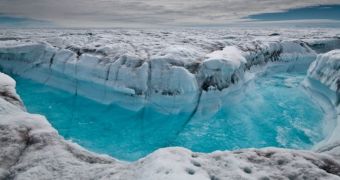In a paper recently published in the journal Nature Geoscience, a team of researchers argue that, according to evidence at hand, Greenland's ice shelf has high chances to get a whole lot smaller way sooner than anyone would expect.
Since the melting of this massive block of ice is expected to translate into a noteworthy increase in global sea levels, specialists warn that, the faster it melts, the sooner and the worse coastal communities could be affected by this phenomenon.
What's interesting is that, as detailed in the paper in the journal Nature Geoscience, Greenland's ice shelf is not melting at a fairly rapid pace simply because of climate change and global warming, Phys Org informs.
Thus, it appears that this ice block's rapid melting rate is also due to dust particles that are embedded in it, the scientists behind this research project explain. This is because dust particles tend to absorb and hold more heat.
While analyzing information concerning the appearance and the size of Greenland's ice shelf between the years 2009 and 2013, scientists found that this part of the world was melting not just around its edges, but also at the interior.
It is now believed that, while it is true the global warming and climate change are the ones to blame for the melting around the edges, the fact that Greenland's ice shelf is getting smaller around its waistline need be attributed to the presence of dust particles in its makeup.
More so given the fact that, as shown by information obtained with the help of satellites, the melting is taking place in areas where temperatures remain below zero degrees Celsius all year round. Hence, heat-trapping dust particles are the most likely culprits.
Although not directly, climate change and global warming are the ones to have sprinkled dust particles on Greenland's ice shelf. As explained in Nature Geoscience, they did so simply by making ice disappear from parts of the Arctic. Later on, local winds took care of carrying the exposed dust around.
“Our analysis of remote sensing data indicates that the springtime darkening since 2009 stems from a widespread increase in the amount of light-absorbing impurities in snow, as well as in the atmosphere,” the researchers write in the Abstract to their paper.
Furthermore, “We suggest that the transport of dust from snow-free areas in the Arctic that are experiencing earlier melting of seasonal snow cover as the climate warms may be a contributing source of impurities.”
Scientists warn that, should this trend continue, it is likely that Greenland's ice shelf will eventually melt in its entirety. Should this happen, global sea levels could rise by as much as 24 feet (about 17.6 meters). Needless to say, coastal communities will be the ones hit the hardest by such a major change in the geography of our planet.

 14 DAY TRIAL //
14 DAY TRIAL //